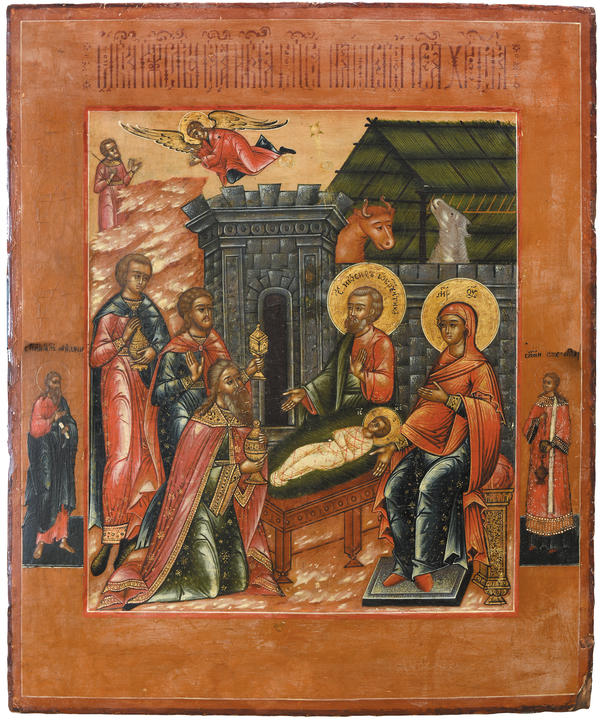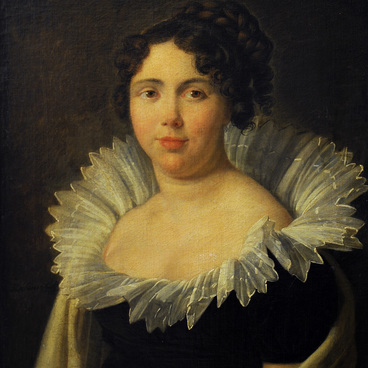Icon painting started to depict the subject of the Nativity of Jesus in Early Christianity and by the 7th century, this plot was already widely used. The depictions were based on canonical gospels and the apocryphal Protoevangelium of James, Gospel of Pseudo-Matthew and other texts. They related that Christ was born in Bethlehem to where Joseph took Mary to take part in a census of all the world commanded by the Roman Emperor. Following his order all married couple had to return to towns where the husband’s ancestry was from. When the Virgin Mary and Joseph came to Jerusalem, there was no place for them in the inn, and the spouses had to spent the night in a cave where Jesus was born.
The Nativity of Jesus
Время создания
The first part of the 19th century. Icon-painting villages from the Vladimir Region.
Размер
37x30,5 cm
37х30.5x2.5 сm
37х30.5x2.5 сm
Техника
Wood (a solid board (linden) with a shrine, two cut-in opposite splines (oak). The canvas is not visible, levkas, tempera, and gilding.
Выставка
0
Открыть в приложении#3
Unknown Author
The Nativity of Jesus
#2
#10
The icon from the collection of the Orenburg Regional Museum of Fine Arts was pained by an unknown artist from one of the icon-painting villages in the Vladimir Region in the first half of the 19th century. The Nativity plot depicted on the icon does not comply with the icon-painting canon established in Russia in the 17th century. The painter shifted the focus from the Mother of God and the manger with a newborn to the Magi who had arrived from the East to worship Jesus. The main subject of the painting is enriched with various images and details. A painter could add them at his own discretion or at the discretion of a person who ordered the icon. At that time Russian icon painters were under the influence of the European art and they used to combine even different subjects on one and the same icon simultaneously depicting several engravings of western masters.
#5
Joseph is depicted sitting on the left side from the newborn Jesus who is swaddled and decorated with ribbons while the Mother of God is sitting on an impressively decorated throne on the right side. Until the mid of the 17th century Mary was depicted in a reclining posture to emphasize the actual details of the Nativity.
The Magi brought to the newborn gifts of gold, frankincense and myrrh, an essence used to wrap bodies of the deceased. In account with the Christian tradition three Magi, namely a young man, a middle-aged man and an old man came to Jesus. They appeared before the Holy Family wearing robes of the Kings decorated with gold and jewels.
#6
The icon also contains the depiction of the cave, such as the shape of the mountains, the manger of Jesus, animals in the stable as well as some attributes of Bethlehem, such as the battlements of a tower and walls of the fortifications constructed from stone blocks.
#7
The depiction of such fortifications was common for western icon painting.
#8
The painter depicted an angel above the main characters of the icon who is announcing the Nativity to a young shepherd.[2] There is a star to his right throwing its light on the child. It must be the Star of Bethlehem followed by the Magi to find Jesus.
#11
Orenburg Regional Museum of Fine Arts
читать дальшескрыть
00:00
00:00
1x
The Nativity of Jesus
Время создания
The first part of the 19th century. Icon-painting villages from the Vladimir Region.
Размер
37x30,5 cm
37х30.5x2.5 сm
37х30.5x2.5 сm
Техника
Wood (a solid board (linden) with a shrine, two cut-in opposite splines (oak). The canvas is not visible, levkas, tempera, and gilding.
Выставка
0
Открыть в приложении
Поделиться



